Le Programme de recherche des cliniciens étudiants ADC/DENTSPLY 2013 s’est tenu à Toronto lors du congrès annuel de l’ADC. Ce concours national de recherche clinique invite des étudiants des 10 facultés de médecine dentaire agréées du Canada à présenter devant des juges des démonstrations cliniques de leur travail de recherche.
Alanna Junaid, de l’Université du Manitoba, a été la gagnante pour 2013. Son étude ex vivo de contrôle de cas portant sur le lien entre le torus buccal et les facteurs mécaniques et systémiques locaux. Son premier prix lui donne droit à un voyage tous frais compris – payé par DENTSPLY – au congrès annuel de l’Association dentaire américaine (ADA) 2013 à la Nouvelle-Orléans, pour y présenter sa recherche dans le cadre du programme scientifique de l’ADA.
« Ma participation au programme de recherche m’a permis de rencontrer d’autres chercheurs étudiants de partout au pays. Il a par ailleurs été très inspirant et motivant de constater la grande qualité de la recherche réalisée par chaque participant. Le programme est une excellente façon de reconnaître le travail et le dévouement des cliniciens menant des études de premier cycle. Il a été pour moi un honneur de représenter l’Université du Manitoba cette année », dit Mme Junaid.
Dans le concours de cette année, Hannah Kashyap de l’Université McGill s’est classée deuxième. Les travaux de Mme Kashyap et de sa collègue Carly Jade Dool portaient sur les obstacles qui nuisent à la prestation de services dentaires mobiles dans les communautés défavorisées et elles ont élaboré un modèle de travail d’une unité mobile permettant de surmonter certains de ces obstacles. « Présenter un projet de recherche a été une expérience stimulante qui m’a permis de rencontrer et de nouer des liens avec d’autres étudiants, des professionnels ainsi que des membres de l’industrie dentaire. Nos discussions m’ont été d’une très grande valeur et j’espère pouvoir maintenir ces relations », explique-t-elle. Son prix consiste en une somme de 1000 $ versée par DENTSPLY.
Depuis plus de 40 ans, DENTSPLY commandite la Programme de recherche des cliniciens étudiants, qui a pour but « de susciter des idées, d’améliorer les communications et, par-dessous tout, d’accroître la participation des étudiants au progrès de la profession dentaire ».
La division canadienne de l’Académie Pierre Fauchard (APF) rend également hommage aux cliniciens étudiants qui participent au concours en leur présentant une bourse en reconnaissance des efforts déployés pour la promotion de l’éducation dentaire, indépendamment de leur carrière universitaire.
 Première rangée (g. à d.) : Dr Barry Dolman, président de la division canadienne de l’APF; Hannah Kashyap, Université McGill; Jason Zimmerman, Université Western; Joel Meyerson, Université de Toronto; Dr Peter Doig, président de l’ADC; David Hancin, vice-président et directeur général, DENTSPLY Canada. Deuxième rangée (g. à d.) : Alanna Junaid, Université du Manitoba; Godwin Cheung, Université de la Colombie-Britannique; Shayan Sadeghi, Université de Montréal; Carly Jade Dool, Université McGill. Troisième rangée (g. à d.) : Katelyn Brodersen, Université Dalhousie; Jooseong (Justin) Kim, Université de l’Alberta; Marie-Hélène Perreault, Université Laval.
Première rangée (g. à d.) : Dr Barry Dolman, président de la division canadienne de l’APF; Hannah Kashyap, Université McGill; Jason Zimmerman, Université Western; Joel Meyerson, Université de Toronto; Dr Peter Doig, président de l’ADC; David Hancin, vice-président et directeur général, DENTSPLY Canada. Deuxième rangée (g. à d.) : Alanna Junaid, Université du Manitoba; Godwin Cheung, Université de la Colombie-Britannique; Shayan Sadeghi, Université de Montréal; Carly Jade Dool, Université McGill. Troisième rangée (g. à d.) : Katelyn Brodersen, Université Dalhousie; Jooseong (Justin) Kim, Université de l’Alberta; Marie-Hélène Perreault, Université Laval.
+++++
Le JADC a le plaisir de publier une version condensée des sommaires qui ont été présentés dans le cadre du Programme de recherche des cliniciens étudiants ADC/DENTSPLY 2012. Pour être admissible, le projet de recherche doit s’inscrire dans l’une des deux catégories suivantes : « applications et techniques cliniques » ou « science et recherche fondamentales ». Les étudiants doivent indiquer le but de leur étude, fournir des renseignements généraux, décrire brièvement la façon dont l’étude a été menée et présenter les résultats de l’étude et leur signification possible. Les candidats retenus sont choisis par leur faculté respective; ces candidats doivent poursuivre des études de premier cycle au moment de la présentation de leur projet et ils doivent être membres de l’ADC. Neuf facultés de médecine dentaire ont participé au programme cette année.
Les sommaires sont publiés dans la langue de soumission.
+++
1re Place
Influence of single file endodontics on apical transportation in curved root canals: an ex vivo micro-CT study
Par : Alanna Junaid, Université du Manitoba
Conseiller : Dr Rodrigo Cunha
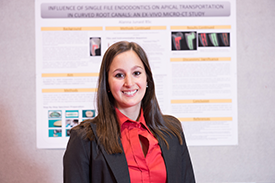 Alanna Junaid
Alanna Junaid
Canal shaping via mechanical instrumentation is considered to be one of the most difficult tasks in root canal therapy. The canal should ideally be enlarged evenly in all directions to ensure complete disinfection and maintenance of the original position, thereby minimizing the risk of blockage, perforation and ledge creation. When the canal is transported from its original position, obturation may also be compromised, resulting in a poor apical seal. This study compares apical transportation in curved root canals when instrumenting with a single WaveOne™ (DENTSPLY Tulsa Dental Specialties,Tulsa, OK) file in reciprocating motions to that incurred when using a sequence of Twisted Files™ (SybronEndo, Orange, CA) in continuous rotating motion.
Forty mesial canals of mandibular molars were evenly allocated into 2 balanced groups taking into account canal length (average 17 mm) and curvature (average 20º). Canals were accessed in a conventional manner and a size 15 K-file was negotiated to working length in the presence of NaOCl. The canals were instrumented according to the manufacturer’s protocol. Pre- and post-instrumentation micro-CT scans were superimposed to assess apical transportation at the 1, 2, 3, 4 and 5 mm sections.
No statistically significant difference (p > 0.05) was found between the WaveOne and Twisted Files groups. The results suggest that a WaveOne file used in reciprocating motion does not increase apical transportation in curved canals when compared to conventional multi-file rotary preparations. Single-file reciprocating motion instrumentation techniques may allow for increased efficiency, reduced operator fatigue and decreased incidence of torsional fractures, without increasing the occurrence of adverse events associated with elevated levels of apical transportation.
+++
2e place
Mobile dentistry... not just a perio problem!
Par : Hannah Kashyap et Carly Jade Dool, Université McGill
Conseiller : Dr Kwong Li
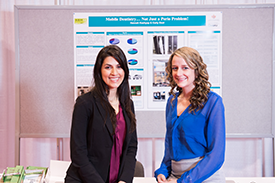 Hannah Kashyap (g.) et Carly Jade Dool
Hannah Kashyap (g.) et Carly Jade Dool
Our goal was to investigate the major obstacles in delivering mobile dentistry to underprivileged communities through a survey of dental outreach program directors in North America, and to design a working model of a novel mobile dental unit to help alleviate some of these obstacles.
We hypothesized that the largest hurdle with delivering mobile dental care is the time and manpower required to assemble and disassemble equipment, due to the unavailability of a suitable compact and ergonomic dental unit. We developed a survey to further investigate these issues and compared mobile dental programs and units in North America. We then designed a working scale model of an innovative and self-sufficient dental unit. This prototype was designed to facilitate transport and storage.
The largest issue reported in delivering mobile dentistry was cost, as the majority of these programs offer pro bono dental care. We postulated that this cost is not only a result of the unit, but also the expenses related to daily dental materials. Ergonomics was the second largest reported issue with mobile dentistry. This is largely due to the fact that that these dental units lack the capacity to store adequate dental materials used on a daily basis. Finally, assembly and disassembly time of the dental clinics has proved a significant hurdle. We have succeeded in designing a novel, self-sufficient mobile dental unit which houses all the dental materials and equipment required for basic dental care.
++++
Single unit implant abutment selection: which abutment to choose?
Par : Katelyn Brodersen, Université Dalhousie
Conseiller : Dr Mark Vallee
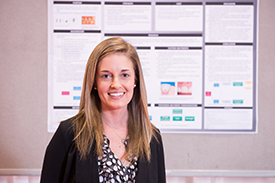 Katelyn Brodersen
Katelyn Brodersen
Single unit implant restorations have become increasingly popular among clinicians and patients. Various factors influence abutment selection and lead to decisions concerning the abutment material—whether to select stock or custom abutment, as well as cement or screw-retained abutment. The purpose of this research was to determine what material and type of single unit implant abutment to select when treatment planning an implant case, and to provide guidelines for selecting an abutment.
A literature review was conducted from PubMed and the Cochrane Library using various combinations of the following search terms: dental implant, abutment, custom, standardized, titanium, ceramic, esthetics, strength. Searches were limited to clinical trials, randomized controlled trials and systematic reviews written in English.
Creating a gingival margin that mimics the cemento-enamel junction of a natural tooth and achieving the proper emergence profile are challenges in implant dentistry. Depending on the inter-arch distance—being greater or less than 5 mm—a cement-retained crown or screw-retained crown should be selected, respectively. When selecting an implant for the anterior region, it is important to consider the soft tissue, esthetics, cost and strength. Ideally, a custom abutment followed by an all-ceramic or porcelain-fused-to-metal crown is recommended. In the posterior region, stock or custom titanium abutments are indicated due to their simplicity, strength and cost effectiveness. Customized abutments, which are no more costly than stock abutments, can be used to optimize anatomic dimensions and soft tissue contour to achieve the proper angulation and preparation of subgingival margins.
+++
Neural crest and stemness gene expression by human gingival fibroblasts
Par : Godwin Cheung, Université de la Colombie-Britannique
Conseiller : Dr Lari Häkkinen
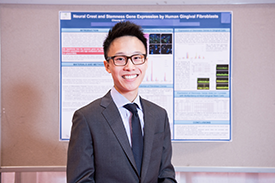 Godwin Cheung
Godwin Cheung
Human gingival fibroblast cultures contain mesenchymal stem cells (MSC). Embyronic stem cells highly express stemness genes (c-Myc, Klf4, Sox2, Oct4, Nanog, Rex1, Lin28) responsible for stem cell characteristics and may be pertinent to MSC regeneration and differentiation. Our objective was to compare stemness gene expression in gingival fibroblast populations to their multipotent differentiation capacity and confirm their neural crest origin. We hypothesize that stemness genes are highly expressed in fibroblast clones with multipotent differentiation capacity (i.e., MSC).
Gingival fibroblast cultures (parental cultures) established from healthy human donors were used to generate clones (CFU-F technique). Sixteen clones with the highest self-renewal capacity were assessed for osteogenic, adipogenic and chondrogenic differentiation. Neural crest and stemness gene expression was analyzed using RT-PCR.
Fibroblast clones exhibited a range of osteogenic, adipogenic and chondrogenic differentiation. Two clones with no differentiation and 4 with tripotency were further analyzed. The parental cultures and selected clones variably expressed neural crest markers (Nestin, Snai1, β3-tubulin, Sox9), suggesting that gingival fibroblasts and MSC are neural crest derived. All cell lines expressed stemness genes c-Myc, Klf4 and Sox2, while Rex1 and Lin28 were absent. The parental cultures did not express Nanog, while clones showed variable expression. No cell line expressed Oct4a, while parental fibroblasts and most clones expressed Oct4B and Oct4B1 transcripts. Findings suggest that human gingival fibroblasts and MSC are neural crest derived, while classical stemness gene expression shows no correlation to the multilineage differentiation potential. Better markers to predict multipotency are therefore needed for regenerative therapy.
++++
Accuracy of laser scanned models compared to CBCT and plaster models
Par : Jooseong (Justin) Kim, Université de l’Alberta
Conseillers : Dr Giseon Heo et Dr Manuel Lagravere
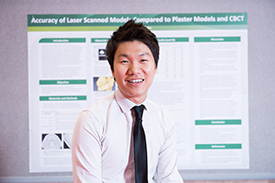 Jooseong (Justin) Kim
Jooseong (Justin) Kim
Digital scanners are increasingly being incorporated into orthodontic offices and institutions, primarily in response to the costs and space related to storing and maintaining the physical models. While the cone-beam computed tomography (CBCT) has proved to exhibit accurate measurements, its role in orthodontic settings is limited due to the economic and convenience factors.
The aim of this study was to compare the accuracy of measurements obtained from the 3D laser scans to those taken from the CBCT scans and those obtained from plaster models. Eighteen different measurements—including mesiodistal tooth width, and arch length and width—were selected. CBCT scans and plaster models were prepared from 60 patients. Plaster models were scanned using the Ortho Insight 3D Laser Scanner and the selected measurements were measured using its software. CBCT scans were imported and analyzed using the Avizo® software. The plaster models were measured using a digital caliper. Descriptive statistics and concordance correlation coefficient (CCC) test were then completed. CCC results show that the values obtained by the 3 methods were highly correlated in all measurements at > 0.73. The largest mean difference between values and methods found was 0.59 mm ± 0.38.
Plaster, CBCT and laser-scanned models each have their own advantages and disadvantages. The present results show that the laser-scanned models are highly accurate to plaster models and CBCT scans. This gives practitioners an alternative— they can take into consideration the advantages of laser scanned models over plaster models and CBCT reconstructions.
+++
Analyses of matrix adhesion in diabetic cardiomyopathy
Par : Joel Meyerson, Université de Toronto
Conseiller : Dr Boris Hinz
 Joel Meyerson
Joel Meyerson
Prolonged hyperglycemia in diabetics leads to glycation of extracellular matrix proteins. Glycated matrix proteins mediate the conversion of cardiac fibroblasts to pro-fibrotic myofibroblasts, specialized cells that produce the scarring of the cardiac interstitium seen in diabetic cardiomyopathy. The formation of myofibroblasts is driven in part by glycated matrix proteins that signal through matrix adhesions. In diabetic cardiomyopathy, the critical molecules of matrix adhesions that regulate myofibroblast differentiation are not defined.
A new method was modified to allow isolation of intact matrix adhesions from human cardiac ventricular fibroblasts that attach to glycated collagen, in order to define their molecular composition. Cells were plated on native or methylglyoxaltreated type I rat-tail collagen for 3 hours, swollen with a hypotonic triethanolamine solution, and detached from collagen substrates by shear force. Isolated adhesion proteins were examined by immunofluorescence and immunoblotting for the focal adhesion proteins vinculin and beta 1, as well as cytosolic protein AkT.
We were able to optimize a hypotonic/shear method to reproducibly isolate intact adhesions from human cardiac fibroblasts. Utilizing this protocol illustrated decreased focal adhesion structures in the diabetic model. Phase contrast microscopy confirmed complete removal of cell bodies. Immunoblotting confirmed expulsion of cytosolic proteins with isolation of focal adhesion associated proteins; immunofluorescence imaging showed retention of intact adhesions that exhibited vinculin and beta 1 staining with characteristic lamellipodia, filopodia and focal streaks. These structures were more robust and well defined in native collagen versus glycated collagen simulating the diabetic condition.
++++
Postoperative complications associated with the retromandibular approach: a retrospective analysis of 118 subcondylar fractures
Par : Marie-Hélène Perreault, Université Laval
Conseiller : Dr Carl Bouchard
 Marie-Hélène Perreault
Marie-Hélène Perreault
The retromandibular approach offers great visualization and direct access to the condylar process for open reduction and internal fixation. The purpose of this study was to evaluate the rate of complications associated with this approach.
The study sample was obtained from the charts of all patients who presented to the department of oral and maxillofacial surgery for the evaluation and treatment of a condylar process fracture from January 2003 to January 2012. Inclusion criteria were: underwent open reduction and internal fixation (ORIF) of the condylar or subcondylar area; have a complete and available medical chart. Exclusion criteria were: patient treated endoscopically or by other approaches; patient with preoperative facial paralysis. The data collected were: age, gender, mechanism of injury, anatomic location, concomitant facial fractures, follow-up time, antibiotic protocol, and complications.
108 patients (118 condyles; 81 males), ages 14 to 82 (35.6 ± 15.8), met inclusion criteria. Six patients never returned for postoperative visits and the mean follow-up time for all other patients was 6.5 months (8 days to 5.5 years). Twenty-six (22%) temporary and 1 permanent facial paralysis were noted. Nine (7.6%) patients had persistent partial facial paralysis at their last visit. Fourteen (11.9%) cases of infection, 4 salivary fistulas, 2 sialoceles, 1 Frey syndrome and 2 seromas were observed.
The retromandibular approach is a safe method for the treatment of condylar process fractures and complications are rare. Permanent damage to cranial nerve VII is extremely rare, but temporary facial paresis is not uncommon.
+++++
Effect of calcified tissue cell products on cell activity
Par : Shayan Sadeghi, Université de Montreal
Conseiller : Dr Antonio Nanci
 Shayan Sadeghi
Shayan Sadeghi
Cells that form calcified tissues secrete various non-collagenous proteins (NCPs) that play critical roles in regulating cell activities and mineral formation. ODAM and AMBN are two examples of NCPs that are also ameloblast products. ODAM is expressed in ameloblasts during enamel formation as well as in the junctional epithelium (JE), and is found pathologically in some epithelial cancers. The exact functionality of this protein and its effect on cell activity is still largely unknown. AMBN plays a major role in enamel formation, and recent studies suggest it may also be implicated in bone formation. The goal of this study was to better understand the role of ODAM in the function of JE cells and to evaluate the potential role of AMBN in bone formation.
ODAM and AMBN were overexpressed in various epithelial cells and osteogenic cells, respectively. Cell functionality was assessed using a variety of methods—including immunofluorescence—to visualize protein expression and cell shape, while mineralization was assessed with Alizarin Red S staining.
Our study shows that the overexpression of ODAM has an effect on cell shape and cell division, and that the effects of ODAM may be cell-type dependent. We also found that the overexpression of AMBN did not enhance the degree of mineralization, suggesting that AMBN may not have a physiological role in bone formation. This does not however exclude a potential pharmacological use. A better understanding of the roles of ODAM and AMBN in physiology and pathology may offer insight into the development of novel therapeutics.
+++
Proteome and peptidome of human acquired enamel pellicle on deciduous teeth
Par : Jason Zimmerman, Université Western
Conseiller : Dr Walter Siqueira
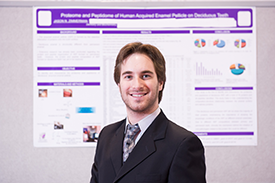 Jason Zimmerman
Jason Zimmerman
Understanding the composition and structure of the acquired enamel pellicle (AEP) has been a major goal in oral biology. Exhaustive exploration has provided a comprehensive identification of more than 100 proteins from AEP formed on permanent enamel.
AEP formed on deciduous enamel has not been subjected to the same biochemical characterization scrutiny as that of permanent enamel, despite the fact that deciduous enamel is structurally different from permanent enamel. We hypothesized that the AEP proteome and peptidome formed on deciduous enamel may also be composed of unique proteins, some of which may not be common with AEP of permanent enamel explored previously.
Pellicle material was collected from 10 children and subjected to mass spectrometry analysis. A total of 76 pellicle proteins were identified from the deciduous pellicle proteome, and 38 natural occurring AEP peptides were identified from 10 proteins. The deciduous and permanent AEP did not share the majority of their proteins, suggesting that primary AEP proteome/peptidome presents different trends than those observed in the permanent AEP proteome/peptidome, and emphasizing the importance of studying the physiologic conditions of the AEP on different enamel substrates. Due to different AEP compositions between primary and permanent teeth, clinically the mechanism behind the initiation of oral pathologies related to this protein film could be different. This is the first study to provide a comprehensive investigation of in vivo AEP formed on deciduous enamel.
+++
Photos : Teckles Photos Inc.
